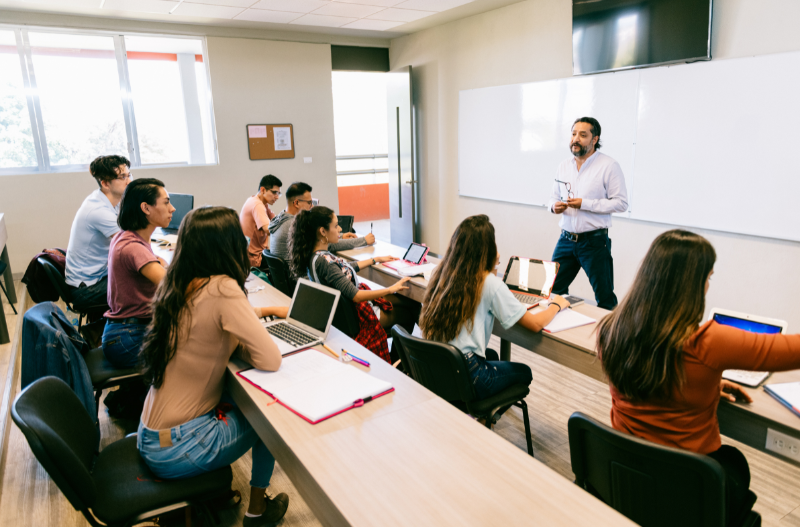Introduction
Mastering a language is a multifaceted journey that extends well beyond the traditional classroom boundaries. Integrated learning, combining in-class and out-of-class experiences, forms the cornerstone of effective language acquisition and proficiency. We explore this essential educational strategy, revealing how the amalgamation of structured classroom activities and flexible real-world practice can create a rich, dynamic, and successful language learning experience.
In the educational landscape, in-class learning offers a controlled, structured environment where foundational linguistic skills are developed through direct instruction, immediate feedback, and interactive activities. However, to achieve fluency and cultural depth, students must apply and extend these skills in the real world, necessitating an integrated learning approach.
This article explores the complementary roles of in-class and out-of-class learning in the language education journey. It highlights strategies for educators to facilitate the integration of In-Class and Out-of-Class learning, ensuring that students not only acquire knowledge but also apply it in diverse real-life contexts. Additionally, we provide practical tips for students, empowering them to leverage integrated learning to maximise their language potential.
The Complementary Roles of In-Class and Out-of-Class Learning
In the realm of language education, the distinction between in-class and out-of-class learning transcends mere location, embodying a dynamic interplay of teaching methodologies, learner autonomy, and language application. Each environment, when integrated, provides a holistic experience that elevates language proficiency and cultural understanding.
In-class learning, characterised by its structured approach, ensures comprehensive language coverage, from grammar and vocabulary to pronunciation and discourse. The integrated learning model leverages this structure, offering immediate feedback and interactive activities that lay the groundwork for language acquisition. This immediate teacher feedback is pivotal, reinforcing correct usage and clarifying complex rules, essential elements of integrated learning.
Moreover, in-class sessions often include interactive activities like group discussions, role-plays, and presentations, fostering a communicative environment that is vital for developing fluency and confidence. These activities simulate real-life interactions, encouraging active and creative language use.

Conversely, out-of-class learning, with its flexibility and personalisation, allows learners to explore language in real-world contexts, thus reinforcing the lessons learned in class. This aspect of the integration of In-Class and Out-of-Class learning enables students to connect language with its cultural backdrop, enhancing their real-world application skills.
Recognising and leveraging the strengths of both in-class and out-of-class learning creates an immersive, integrated learning experience that enriches the language education journey. As discussed in the Fluency School blog article “From Fragmented to Fluent Language Learning,” integrated learning is key to solving the incompletion often experienced in language education.
How Teachers Can Help Students Connect These Experiences
Bridging the gap between in-class and out-of-class learning is crucial for a seamless, effective language education journey. Teachers play an integral role in this integration, helping students apply classroom knowledge in real-world scenarios. Through integrated learning, educators can implement strategies that connect these learning experiences effectively.
Encouraging reflection and goal-setting allows students to contemplate their in-class learnings and how these can be applied outside the classroom, an essential aspect of integrated learning. Teachers can guide students to set clear, achievable objectives for their out-of-class learning, thus enhancing the integrated learning experience.

Providing curated resources and recommendations helps students navigate the extensive array of materials available, ensuring that these complement in-class lessons and adhere to the principles of integrated learning. Incorporating out-of-class activities into lesson plans offers students a clear path to extend their learning journey beyond the classroom, reinforcing the concept of integrating In-Class and Out-of-Class learning.
Fostering a supportive learning environment extends the educational experience outside the classroom, motivating students to continue their language journey. This approach, a cornerstone of integrated learning, encourages continual practice and exploration.
By implementing these strategies, teachers can effectively bridge the in-class and out-of-class learning divide, enhancing students’ overall language proficiency. This integrated approach not only enriches the learning experience but also prepares students to confidently and effectively use the language in diverse contexts. As highlighted by Vanderbilt University’s guide on teaching outside the classroom, the integration of In-Class and Out-of-Class learning experiences have a range of benefits for both students and instructors, reinforcing the importance of this educational approach.
Practical Tips for Students to Enhance Language Proficiency
Language learning extends far beyond the classroom walls, and students who actively engage in integrated learning experiences often achieve higher levels of language proficiency and fluency. Here are practical tips to make this integrated learning effective:
- Develop a Balanced Study Schedule: Crafting a schedule that harmonizes in-class learning with out-of-class practice is critical. This schedule should not only allocate time for attending classes and completing assignments but also for engaging in self-directed language activities like listening to podcasts, reading articles, or practicing speaking. For instance, if your course focuses on grammar and vocabulary during the week, you might dedicate weekends to watching films or participating in language exchanges in the target language. This approach ensures consistent exposure and application of the language, facilitating gradual and steady progress in language acquisition.
- Regular Review and Application: Consistently revisiting class notes and materials helps reinforce what has been learned. Students should make it a habit to review their notes, identify key concepts, and apply them in various contexts. For example, after learning new vocabulary, try to use these words in sentences or find them in articles or videos. This active engagement with the material not only deepens understanding but also aids in long-term retention.
- Embrace Technology for Language Learning: With the abundance of language learning apps, online courses, and digital resources, technology is a boon for language learners. These tools offer interactive and immersive ways to learn a language, from grammar exercises and vocabulary games to simulated conversations and pronunciation practice. Moreover, technology can connect you with native speakers around the globe, offering real-time practice and cultural exchange. Integrating these digital resources into your study plan can greatly enhance your linguistic skills and cultural comprehension.
- Engage in Real-world Language Practice: Practical application of language skills in real-life situations is invaluable. Joining language clubs, participating in language exchange meetups, or engaging in community activities where the target language is spoken allows for practical use of language in conversational settings. This not only improves speaking and listening skills but also increases confidence in using the language in various contexts.
- Reflect and Adjust Your Learning Strategies: Continuous reflection on your language learning journey is essential for sustained improvement. Regularly assess your progress, identify areas of strength and weakness, and adjust your learning strategies accordingly. This might mean changing the focus of your study, trying new learning methods, or seeking additional resources or support for challenging areas.
By embracing these strategies, students can significantly enhance their language proficiency. Integrated learning, with its focus on both academic and real-life language application, offers a comprehensive approach to language education. This method not only improves language skills but also prepares students for the nuanced demands of real-world communication.
Conclusion
Integrated learning, bridging in-class and out-of-class experiences, is paramount in the language learning journey. This article has highlighted the distinct advantages of each approach, demonstrating how they complement each other to enrich the language learning process. The structured environment of the classroom, with its direct instruction and peer interaction, provides a solid foundation for language development. Conversely, out-of-class learning, with its flexibility and real-world application, enhances cultural understanding and practical language use.
Teachers play a critical role in facilitating integrated learning, employing strategies that connect classroom lessons with real-world experiences. Similarly, students are encouraged to actively blend these learning experiences, utilising strategies that leverage both academic and real-life contexts to enhance their language proficiency.
As we navigate the integrated learning landscape, it becomes clear that this approach not only enriches the educational experience but also fosters a deep, practical understanding of language. We urge readers to apply the integrated learning strategies discussed to enhance their own language learning journey. By doing so, students can achieve a more comprehensive, effective, and fulfilling language education, equipped to face both academic and real-world linguistic challenges with confidence.
In the spirit of integrated learning, we invite you to explore other resources on the Fluency School blog, such as “The Art of Language Learning in Your 20s and Beyond: Fluent and Fearless“, which complements the integrated learning approach by providing further insights into effective language acquisition strategies. Additionally, the guide by Vanderbilt University on teaching outside the classroom reinforces the benefits of integrated learning, offering valuable perspectives on enhancing the educational experience for both students and instructors. Through this holistic approach, language learning becomes a dynamic, integrated journey, rich with opportunities for deep engagement and profound understanding.




